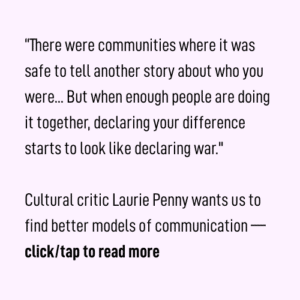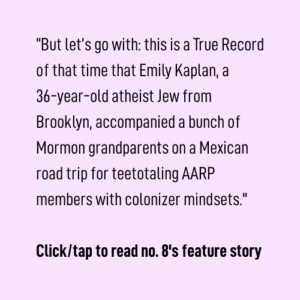Liz Bucar
no. 8, The Road Trip Issue
Autumn 2022
My hunch is I was asked to contribute to this conversation because the editors thought an account of a journalist’s participation in a Mormon tour of Mexico would delve into the murky waters of religious appropriation, a topic I have just published an entire book about. (Ed.: correct!) And while there are Mormon practices that are what I would call profoundly offensive, like the baptism of Anne Frank and Holocaust survivors, I’m struck by a different set of ethical issues — our responsibility when engaging the religion in others.
Telling the Stories of Others
Part of my interest in religious appropriation is a concern with what we owe religious communities we are not part of, the stance those of us who are non-believers might take towards communities we don’t understand and have no desire to join. When conversion is not on the table, what does it mean to adopt a religious practice? To burn some sage in our new home, wear a rosary to be ironically cool, or complete a pilgrimage to someone else’s sacred location? What does it mean as a scholar or a journalist to tell the religious stories of others? The Mormons might be telling a story, but so is the journalist. And as the journalist, they wield the power. Their rendering will be assumed to be unbiased and accurate. Their reader will believe them, not their Mormon companions. The journalist is just as likely to cause harm in this scenario as they are.

My job as a professor is to think critically about religion, and I’m no apologist for it — I’m part of the growing population that identifies as non-religiously affiliated. But I’m also an ethicist, and a human, and I think disdain, disrespect, or just generally looking down on religious communities we are not a part of is the basis for a whole lot of discrimination and violence, as well as general misunderstandings. Rather than pointing out the gymnastics involved in insisting that the events of the Book of Mormon took place in Guatemala and southern Mexico, I’d like us to turn the gaze back on ourselves. To shine a light on the difficulty we have with the religion of others.
As a scholar of religion, I am in many ways in the same position as a journalist: an outsider telling the religious stories of others. So I sympathize with the ethical dilemmas that arise when covering religious topics, and I think seeing writers’ honest reactions to religious people and issues is valuable; it highlights a pervasive dynamic, one that is acutely American. It’s a stance towards the religious other that I see in media coverage of religion as well as in my students, my colleagues, my friends and my family, and sometimes myself: that religious folks are irrational and duped. We can see it from the outside, and perhaps we can help them see it as well. There is an implied hierarchy — “we” are better than “them.”

This is a challenge to teaching religious studies today: most of my students are not religious studies majors, yet most come to class with a whole lot of opinions about what religion is and should be. This stance is an obstacle to public religious literacy as well. Whether we are born into a religious family, exploring faith on our own, or categorically rejecting religion, we are all experts in religion in our own way. And this gets in the way of our learning.
The Recoil Reflex
While working as a reporter for the New York Times in the 1990s, American journalist Dennis Covington visited southern Appalachia to cover the trial of a preacher by the name of Glendel Buford Summerford, who was accused of trying to murder his wife by snakebite. Covington convinced his editor to allow him to stay on, and took a deep dive into the snake-handling hill people who live on Sand Mountain. They speak in tongues, drink strychnine, and of course, handle snakes, all based on their interpretation of the Gospel of Mark 16: 17-18. The book he wrote, Salvation on Sand Mountain, was a finalist for the National Book Award. The Chicago Tribune called it “one of the best books on American religion from the last 25 years.”
But religious studies scholars don’t all agree. In fact, I often use Covington in my introductory courses as an example of how not to approach the study of religion, guided by the brilliant critical reading of Robert Orsi, a leading scholar of American religion. The book starts off promising, Orsi tells us, as Covington offers a model for engaged and interpersonal religious study. For a time he lives among the people of Sand Mountain, befriends them, even picks up a snake himself. He comes to see snake handling “as a way for poor, displaced people…to contend with and to surmount…the violence and danger that bore down on them in their everyday lives.” By trying to understand them on their own terms, he is able to really begin to see them.
This is a bait and switch. The emotional climax of Covington’s book is a moment of disdain and recoil. It comes towards the end, when the preacher Punkin Brown has an interaction with Covington’s young female colleague and Covington feels compelled to stand up and tell Punkin Brown why he is wrong, why his community is wrong, why his faith is outdated. As Orsi puts it, “Covington has inscribed an existential circle, taking a long detour to reestablish the prejudices against snake handlers many readers started it with.” It turns out snake handlers are weirdos after all.
Doing Better

At its core, the ethics of religious appropriation is thinking about how we might more justly deal with religious diversity in the world. But rather than direct our moral outrage at, for example, Mormon grandparents with colonizer mindsets, what would happen if we turned it back on ourselves? If religion coverage just confirms what we already thought we knew, if that’s all we take away from it — that Mormons, like snake handlers, are weirdos after all — that’s a problem. It means we missed an opportunity to really learn about the worldview and values of a community we are not a part of, to try to understand them on their own terms, to truly see them and how American assumptions about religion makes Mormonism possible.
To do anything less implies that the religion is unknowable, beyond our comprehension. But I think we can do better than that.
Liz Bucar is a leading expert in religious ethics, a professor of religion at Northeastern University, and a prizewinning author. Her newest book, Stealing My Religion, unpacks the ethical dilemmas of a messy form of cultural appropriation: the borrowing of religious doctrines, rituals, and dress for political, economic, and therapeutic reasons.

More great reading
from Pipe Wrench no. 8
Searching for Zarahemla
Journalist Emily Fox Kaplan recounts an epic Mormon road trip across Mesoamerica. How many ways are there to tell a story? And how do we know what’s true?
There Are Lots of Ways to Tell a Story
For cultural critic Laurie Penny, we need new models for the “community” part of “communication.” More technology doesn’t equal more understanding.
Travelin’ Mercies
Columnist Breai Mason-Campbell looks back and finds that the faiths of our fathers are not always what fulfill us, and the road to church is not always a road to joy.

